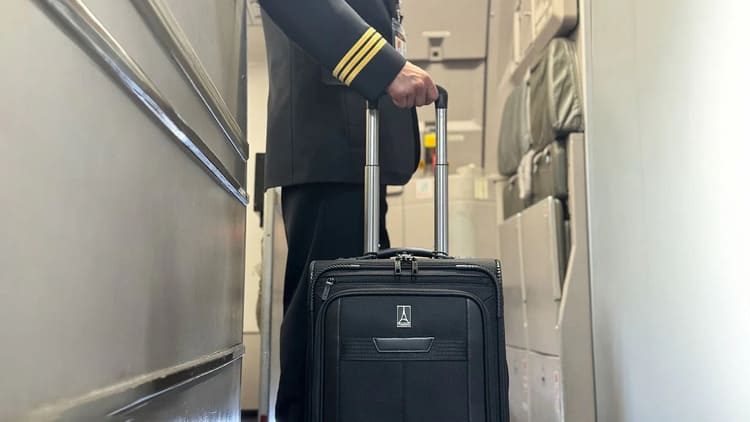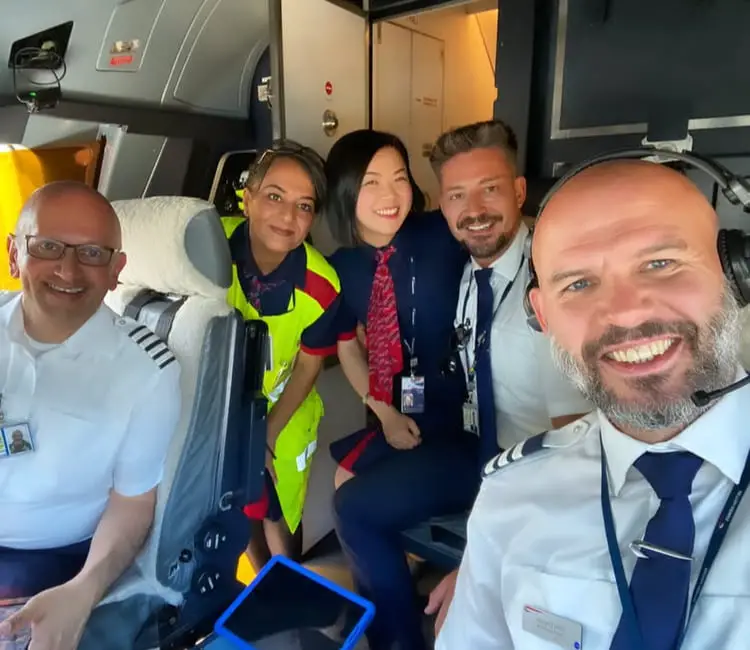
Flying on a commercial airline, you might be sitting next to a pilot and not even realize it.
Off-duty pilots travel frequently, either commuting for work, returning home after a trip, or simply taking a personal vacation.
These pilots blend in with the rest of us, but if you know what to look for, you can often spot them.
Here’s how to recognize an off-duty pilot on your next flight and what makes their journey slightly different from the average passenger’s experience.
1. Where They Sit: First class, Business or Economy?
Off-duty pilots can sit in business or economy, depending on availability and airline policy.
They are not automatically placed in first or business class, but they have a higher chance of being upgraded compared to regular passengers—though they are not the first priority..
Here’s how seating priority works:
- Frequent flyers get first priority. Airlines reward their most loyal passengers with available upgrades before considering staff.
- Deadheading pilots (on duty, traveling for work) get the next priority. They must make it to their next assigned flight, so they’re often seated in business or first class when space is available.
- Off-duty pilots and their families come last. They’ll only get a business class upgrade if there are no frequent flyers or deadheading crew ahead of them.
That said, you may still find an off-duty pilot in economy class if business is full, or if they prefer to keep a low profile.
2. How They Board

Boarding procedures for off-duty pilots depend on whether they are traveling for work, commuting, or on personal travel:
- Work travel (deadheading) – Pilots can board anytime, including preboarding, and usually their boarding pass is always Group 1, no matter where their seat is located.
- Jumpseat travel – They can board at any time, including preboarding, since they may need to coordinate with the flight crew.
- Personal travel in a cabin seat (non-rev leisure travel) – They typically board in Group 3. Non-revs are eligible for upgrades only after all paying customers have been processed.
- Crew in uniform – Some friendly gate agents may allow crew in uniform to preboard as a courtesy, even on personal travel.
If you notice someone boarding with Group 1 or Group 3 but acting very relaxed about it, they might be an off-duty pilot catching a flight.
3. How They Dress

Off-duty pilots generally don’t wear their uniforms, but there are exceptions—especially when they are deadheading (traveling to operate another flight).
In those cases, they often wear their uniform since they will be working immediately after landing.
However, some pilots voluntarily choose to wear their uniform, even when commuting for personal travel.
Why? There are several advantages to flying in uniform:
- Fewer hassles at security checkpoints – TSA agents and airport staff tend to process uniformed crew members more smoothly.
- Easier interactions at the gate – Pilots in uniform might face fewer questions when using jumpseats, standby travel, or priority boarding.
- Professionalism and airline pride – Some pilots simply prefer wearing their uniform, as it reflects their profession and earns them a level of respect.
That said, when pilots choose to wear their own clothes, they are expected to dress in business casual or smart-casual attire. Dress codes vary by airline, but common styles include:
✅ For Men:
- Slacks and a polo shirt – A go-to look that balances comfort and professionalism.
- Button-up shirt and jeans – Previously not allowed, but modern airlines now permit well-fitted, polished jeans as long as they maintain a professional appearance.
✅ For Women:
- Tailored trousers, dress pants, or dark, well-fitted jeans (not ripped) – Paired with a blouse or a t-shirt that isn’t too revealing.
- Skirts or dresses that aren’t too short– Some female pilots opt for a more formal style when commuting, though comfort is key.
Some pilots might still wear their ID badge on a lanyard, though others prefer to keep it tucked away to avoid drawing attention.
4. Their Carry-On Luggage

Off-duty pilots tend to travel light and practical, sticking to the essentials. While their bags may not always give them away, there are a few telltale items that can hint at their profession:
✔️ A small rolling suitcase or flight bag – Compact and efficient, just like they use when on duty.
✔️ A black leather duffel bag – A stylish yet functional favorite among pilots.
✔️ An aviation headset case – If they’re commuting to work, they might carry their personal headset for the cockpit.
✔️ A bag with an airline logo – This could be a branded backpack, tote, or duffel.
✔️ Subtle aviation accessories – A “Remove Before Flight” keychain, airline badge, or aviation-themed tag might be attached to their luggage.(not a guarantee, but a clue!)
4. Their Reactions to Turbulence and Announcements
Off-duty pilots are so accustomed to flying that it feels as routine as taking a bus.
They come well-prepared for flights, bringing their own entertainment, noise-canceling headphones and stay completely relaxed—whether they’re catching up on a book, watching a movie, or napping.
They remain unfazed by turbulence, delays, or slot restrictions because they know these things are just part of flying. More than that, off-duty pilots can sense when something unusual is happening.
If a flight diverts unexpectedly or if there’s a technical issue, they pick up on the small signs, like a discreet conversation between crew members. But unless it’s something serious, they don’t worry.
5. Their In-Flight Behavior: The Cockpit Visit and Crew Interaction

Many off-duty pilots introduce themselves to the flight crew when they board—especially if they work for the same airline.
It’s common courtesy to poke their head into the cockpit before takeoff and say hello to the pilots.
They may ask about weather conditions, estimated time en route, or even exchange pleasantries if they know the crew.
Flight attendants also tend to recognize off-duty pilots, which leads to subtle hints:
- They get extra snacks or drinks without asking. The crew appreciates their presence and might offer small perks.
- They might help with safety situations. In rare cases, off-duty pilots assist with mechanical or safety issues. For example, one pilot once helped crew members avoid a dangerous escape slide deployment, preventing a costly mistake.
- They joke about being asked to do beverage service. Flight attendants sometimes tease off-duty pilots about serving drinks or helping with the meal cart.
6. Their Conversations & Aviation Lingo
Off-duty pilots don’t go around announcing their profession, but you might overhear subtle aviation talk in conversation:
- “Looks like we’re cruising at FL350” (Flight Level 35,000 feet)
- “I wonder if they’re using the ILS approach today” (Instrument Landing System)
- “They’re probably dealing with ATC delays” (Air Traffic Control)
They also might chat casually with flight attendants about industry updates, upcoming schedules, or changes in company policy.
7. Do They Ever Step In During Emergencies?
While rare, there are cases where an off-duty pilot might need to step in and assist a flight crew.
If a pilot on duty becomes incapacitated, an off-duty pilot may be called to the cockpit to assist in landing the aircraft. Airlines keep track of which crew members are onboard, just in case an emergency arises.
In smaller but still important ways, off-duty pilots help with safety awareness, whether it’s advising crew members about a mechanical issue (like the escape slide incident) or keeping an eye out for security concerns.
Final Thoughts: Can You Spot Them?
They might look like just another passenger, but once you know what to look for, they’re easier to spot than you think.
And who knows? Maybe they’re sitting next to you right now.
If you strike up a conversation, you might just walk away with some inside aviation knowledge, a funny cockpit story, or even a tip on how to get the best seat on your next flight.